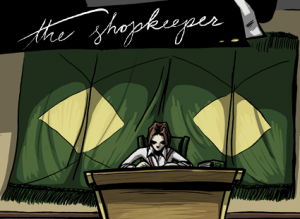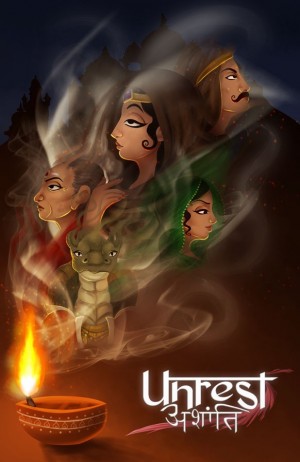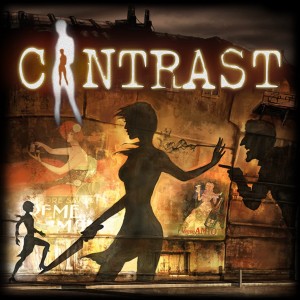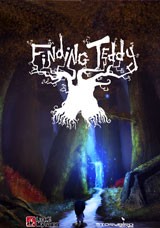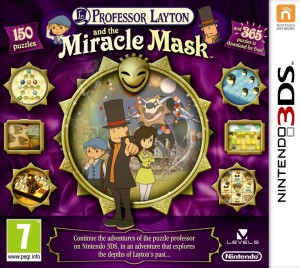The Adventures in Storytelling: Unrest Shopkeeper
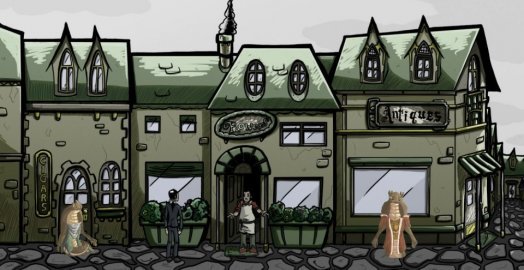
Story and puzzles used to be inseparable in adventure games, like spaghetti and meatballs, bacon and eggs, peanut butter and jelly. But lately, more and more games have been abandoning puzzles altogether in favour of strictly (or at least largely) narrative-driven experiences. Popularized by the likes of Dear Esther, The Walking Dead, and The Stanley Parable, these puzzle-free story games are quickly forming a subgenre all their own. (If you're wondering where all the puzzles have gone: the platformers took 'em.)
For some this change is reason to lament, but for story lovers it can be welcome news. Unencumbered by the need to work in arbitary obstacles where they don't belong, these games are free to tell their stories their way – or at least, the way that players choose to direct them. The experiences can be entirely different, not just between tales limited only by the imagination of their authors, but even within a single game from one playthrough to another. Two such games are Unrest, which takes players into a fantastical version of ancient India to a time of poverty and political strife, and The Shopkeeper, which sees players endlessly seeking a perfectly devious gift in a Victorian-era small English store.
Unrest
Katie Smith
In Unrest, an unusual, RPG-styled narrative adventure funded through Kickstarter, the town of Bhimra has fallen on hard times. Famine, caste tension, and a possible trade alliance with a frightening race of snakes has put the town on edge and left it on the brink of destruction. Five citizens from different walks of life are struggling to survive the upheaval, and even death does not mean game over. There are many different choices of how to handle things, but the decisions don’t matter much in the end, and the lack of puzzles and character depth make this pretty game a trudge to get through.
 The game world is modeled after ancient India but features the fantastical Naga, the snake-like creatures that half the town fears and half the town hates. The story is split into eight short chapters, each focused on one of the five playable characters. Asha is the sole heir to Bhimra, struggling to claim the throne. Chitra is a seasoned diplomat for the Naga Empire, set to retire after sealing a deal with Bhimra. Tanya is the daughter of one of the townsfolk, arranged to marry a boy she despises. Bhagwan is a local priest, tasked with choosing between angry men, sick women, and starving children for whom to give a limited amount of food and medicine. Shyam is the local mercenary who needs to protect the inner city, which may leave out the slums and the poor people within them.
The game world is modeled after ancient India but features the fantastical Naga, the snake-like creatures that half the town fears and half the town hates. The story is split into eight short chapters, each focused on one of the five playable characters. Asha is the sole heir to Bhimra, struggling to claim the throne. Chitra is a seasoned diplomat for the Naga Empire, set to retire after sealing a deal with Bhimra. Tanya is the daughter of one of the townsfolk, arranged to marry a boy she despises. Bhagwan is a local priest, tasked with choosing between angry men, sick women, and starving children for whom to give a limited amount of food and medicine. Shyam is the local mercenary who needs to protect the inner city, which may leave out the slums and the poor people within them.
Regardless of the character, the game centers around making good decisions to survive, which is done by walking around the scenes and talking to the different people. Inventory items are picked up but used only through dialogue, so there are no puzzles to speak of. Objectives can range from simply speaking to certain people, to appointing one new sergeant out of three different candidates, to choosing whether to sell the medicine you are carrying or give it to the sick man who offers you a measly sum of money.
You have a choice between Myth and Mortal at the beginning of the game, where you can either have multiple saves or just one save so you can’t go back on the choices you make. Each chapter starts with a picture of the playable character, along with their basic background and traits. The protagonists all begin with certain unchangeable characteristics, such as being a princess, diplomat, or family man. Other traits can be changed, however, depending on how you choose to respond during conversations. You can opt to be opportunistic, kind, or ruthless, etc., and each conversation has about four responses to choose from that reflect attitudes like rebelliousness, curiosity, or openness. The responses you tend to pick will influence the additional traits each character acquires. It usually doesn’t have any impact on how the story ultimately plays out, but it is interesting to see your influence on the character.
When speaking to others, a dialogue box comes up with their portrait, a link to your journal (which includes what is known about that character), and three bars at the top. The bars signify the level of friendship, respect, and fear that character feels toward you. The responses you choose may influence one of these factors, and a bell will ring if it changes. These factors change the tone of the conversation and the information you learn. If you are open, you may coax them into talking more freely about issues that they would usually be reserved about. But you might be talking to a traditionalist, who doesn’t appreciate you trying to speak about sensitive issues publicly. It is even possible to begin a fight during conversation and die. Fighting is handled through text-based choices, like when three others gang up on you and you’re given choices such as stabbing at the guy to your left, lunging at the opponent in front of you, or hitting the one standing to your right. There weren’t many times that I encountered an option to fight, however. If one character dies in such an altercation, the story continues, giving a brief blurb about what happened as a result, then moves on to the next chapter.
Only Asha appears in more than one chapter, and what happens to the other characters is only mentioned quickly in passing. It is easy to feel connected to each character since you control a lot of their personality, so it’s a shame that most of them don’t have more time on screen, and are largely abandoned between chapters to make way for the next. It’s also too bad that their roles aren’t more relevant to the overall storyline. When you do make a decision, the consequence isn’t fully capitalized upon. The fate of the town is up in the air, but it doesn’t feel like you really contribute or control anything that will help determine its future.
There are plenty of other characters scattered around Bhimra, some of whom only have one line to say while others you can engage in conversation. Some of the same characters are mentioned or can be interacted with in more than one chapter. Among the more notable secondary cast, Vijay is the advisor to the King who respects Asha but feels little friendship or fear of her. Laxmi is the tough wife of a landowner, with whom both Chitra and Tanya can interact. Unfortunately, the characters are one-dimensional, which makes having to slog through all the dialogue a chore. The setting itself makes for a more interesting backdrop. Other than the presence of the Naga, it feels very historical, like it could have been a real town from the ancient past. The distinctly cultural influences are interesting to explore, and the impoverished setting is refreshingly different from other games out there.
Icons at the bottom of the screen include a map, a journal, and inventory. The map shows where you are in the bigger town picture, though there’s no quick travel option. You can’t run through scrolling screens or double-click exits either, so walking from place to place can take a long time. The journal includes a list of current and past quests, a guide to people and places, and the basic history of the land. Rather than drowning players in detail, the information is very basic, which doesn’t go far in helping build the world’s lore. An icon appears next to any information that hasn’t been viewed yet. The inventory includes descriptions of everything. You start off with some items already, including money, and you can buy more items at the market, such as a map or blanket. However, like conversation choices, these decisions don’t seem to matter in the big picture. You’ll use some items through dialogue, but most of the inventory is not used at all.
The game uses an isometric view of the town, giving it a three-dimensional effect. Movement can be controlled in multiple ways, from traditional point-and-click to WASD on the keyboard, or even a controller. Sometimes trying to navigate the world can be tricky, since the character sprites often get stuck on corners of objects and can only speak to others in certain positions. People who can be interacted with have an icon over them, both on the main screen and the map. When you have a decision to make, the map will also show where you must go to make that choice. You’ll find books to read throughout, but they are only a paragraph long, in keeping with the short and shallow journal details.
The hand-painted graphics are detailed and pretty. The town of Bhimra has lots of color, from the browns of the slums to the pastel greens and yellows of the palace gardens. Birds fly by, and the leaves on the trees blow in the wind. The characters are nicely drawn, their robes either ornately designed or plain, depending on their status. The snake-like Naga are humanoid enough not to be creepy, but the way they slither across the screen really helps add to the atmosphere. There are no voice actors, which is a significant factor in a game that relies this heavily on dialogue. There aren’t any ambient noises either, so the music alone is what carries through the game. The soundtrack is suitably moody and culturally appropriate, with drums, flute, and guitar pieces that have a distinct Indian tone, but it can become a bit repetitive over time.
Unrest is quite short, likely only taking about three hours to complete, depending on your reading speed. With the choices you can make, there is some potential replay value, but the few meaningful decisions available are tucked amid tons of the same dialogue, which can become very tiresome to sit through again, although at least you can click your way through conversations. The Indian backdrop is intriguing, but it’s never explored too deeply, and the lack of weight your decisions have on the town’s fate is ultimately frustrating. As a brief foray into a unique cultural setting through the eyes of five distinct characters, those who enjoy conversation-heavy adventures may find it worth a stroll through ancient Bhimra, but those who seek a challenge or more substantial player agency will surely be left feeling restless.
The Shopkeeper
Randall Rigdon
While The Shopkeeper may look like a traditional point-and-click adventure, it’s really not. In fact, it’s very hard to classify what it actually is, other than one of most perplexing, barely-interactive storytelling experiences I’ve ever encountered. As the game opens, a scratchily-drawn young man enters a scratchily-drawn antique store, purportedly to find just the right gift for a picky family member. If the player has any effect or control over anything that happens from this point forward, I wasn’t able to figure it out over the course of several protracted hours and actually “finishing” the experience.
 The Shopkeeper looks like a Victorian-styled, hand-drawn cartoon sketch, although the exact time period isn’t really clear. It’s initially an alluring aesthetic, but the presentation is extremely minimal, as the whole game takes place across only two rooms that lack music or ambient sound and have barely any animation. The animation that is present mostly consists of mouths moving and characters walking from one side of the room to the other, which is really about as exciting as anything gets.
The Shopkeeper looks like a Victorian-styled, hand-drawn cartoon sketch, although the exact time period isn’t really clear. It’s initially an alluring aesthetic, but the presentation is extremely minimal, as the whole game takes place across only two rooms that lack music or ambient sound and have barely any animation. The animation that is present mostly consists of mouths moving and characters walking from one side of the room to the other, which is really about as exciting as anything gets.
The first scene in the game pretty much plays out on its own, with a young British-accented customer walking into the store and talking to the shopkeeper. The ensuing conversation serves mainly as a non-interactive cutscene, but during pauses in the dialogue you can click on random objects in the shop, such as a painting, a bottle, or a clock, and one of the two characters will comment on the object and give some background on it before the automated dialogue resumes.
Unfortunately, I couldn’t see how even this limited interaction had any influence on anything – the characters didn’t even walk up to the objects I clicked on. They simply discussed the objects briefly and the rest of the scene continued as before, without any apparent influence from anything I’d done. No dialogue choices or further interactions are present, and if any changes were made based on what objects I clicked, it simply wasn’t evident enough for me to ever understand or recognize.
It doesn’t help that the dialogue comes off as cryptic and confusing. The characters speak eloquently, but there isn’t really any context behind anything they actually say to each other, usually resulting in confounding nonsense. For example, one scene consists of a conversation of: “What about this one?” “It’s something you may find … of use.” “Hmm..” “Yes. Follow me sir.” The exchanges never explain anything going on; the characters merely continue to speak vaguely to each other in their strange riddle-speak before the scene automatically moves forward to the next. As inexplicable as the dialogue is in its own right, what hurts even more is how excruciatingly flat the voice acting is, giving the whole experience a drab and unsettling feel.
Eventually the shopkeeper invites the young man to speak to the shop owner in the back office, an elderly woman revealed to be the young man’s mother-in-law. The visitor requests money of the woman for his failing business, but she bluntly and angrily condemns him for the suggestion. A journal is displayed in the corner of the screen during this conversation, and you can choose from three oddly-worded phrases on the page such as: “He wanted to diversify” or “His partner was all mouth and no trousers.” But again, I couldn’t figure out how the choice affected the game whatsoever, as the scene seemed to play out the same way no matter what I chose. Every time the man pleaded for money, injecting stories about his interpersonal struggles involving his family or his failing enterprise, and inevitably the woman would reject him and force him to leave the store.
Here’s where the game becomes especially bewildering: the same two scenes repeat over and over and over. Every time the protagonist leaves the shop, the scene automatically resets from the top, with the young man re-entering the store. In some ways, this is reminiscent of one of my favorite movies, Groundhog Day, where Bill Murray experiences an endlessly repeating cycle of the same day over and over. However, in the movie Murray’s character is aware of his repeating day entrapment, whereas in this game I couldn’t tell if any characters retained any knowledge of the previous encounters or not. And unlike the movie, the game never makes any attempt to justify the constant resetting. It merely happens. Again and again and again.
Sometimes there is a slightly different angle given to subsequent visits, but at their core the scenes play out essentially the same way every time: the young man chats with the shopkeeper, the shopkeeper takes him to the back, the man pleads for money, and the elderly owner rejects him. On rare occasions I received a glimpse of the outside street, and even more rarely all the dialogue was radically different, but I never had any idea of how or why any of this was triggered. In one instance, the man walked in and simply whispered, “One… two…” in a disturbingly creepy manner, and then the scene shifted forward. I had no clue what this meant or why it happened; the sequence went over my head along with most everything else in the game.
Eventually, after three hours spent watching virtually the same scenes play out repeatedly, the scenario suddenly changed dramatically. [Possible spoiler alert – or not] I don’t know how or why, but the lights cut out inside the shop while talking with the elderly woman, creating a period of complete blackness that lasted a good three to four minutes, making me think I had somehow lost the display on my monitor. The darkness finally ended, however, and what followed was a new dialogue between the shopkeeper and the young man musing about the many confusing things that had supposedly happened during the blackout. With the story seemingly primed to go in a long-overdue new direction… suddenly the credits appeared. Adding to the perplexity, after the credits rolled yet another new scene suddenly restarted in the shop – just as it always had – except now there were even more dialogue variations that I hadn’t heard before. [End sort-of-but-not-really spoiler]
Usually the end credits mean a game has ended, but maybe it really had not? Maybe there is no end? Honestly, I played The Shopkeeper far longer than it held my interest and I was never able to make any sense of it. I’m still not sure if it is trying to be a game or an art piece or what. As far as I could tell, it isn’t making any profound statements, and if there is some sort of deeper message going on here, it’s far too ambiguous to make the invested time worthwhile. Even now, after apparently finishing the “game”, I’m still not convinced that there is any method to the madness. The only people I can imagine The Shopkeeper making any sense to are its creators. I would certainly be interested in hearing from them what the whole thing is supposed to mean (if anything), but on its own, this baffling and rather grim digital performance piece is simply too bizarre to make it anything more than a giant head-scratcher that never satisfies the player’s itch.








